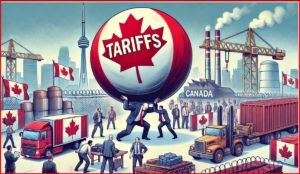|
Trump has imposed tariffs of 25% on goods coming from Mexico and Canada, 10% on Canadian energy, and an additional 10% on goods from China. He justified these actions by claiming they would force Mexico and Canada to address issues related to undocumented migration and drug trafficking. However, while precursor chemicals for fentanyl come from China and undocumented migrants enter through the southern border with Mexico, Canada accounts for only about 1% of both issues.
The Wall Street Journal, typically considered a conservative publication, criticized Trump, labelling this as the “dumbest trade war in history.” The Journal stated, “Mr. Trump sometimes sounds as if the US shouldn’t import anything at all, that America can be a perfectly closed economy making everything at home. This is called autarky, and it isn’t the world we live in or one that we should want to live in, as Mr. Trump may soon find out.”
This misguided tariff policy will cause untold damage to the global economy, including the US. Americans will suffer the impact of higher prices and shortages of key products imported from Canada and Mexico. The various North American free trade agreements aimed to improve manufacturing efficiencies and meld the three economies to maximize productivity and the free flow of essential inputs into production. Canada is the number one supplier of steel and aluminum and there are no readily available substitutes for these crucial inputs. A plethora of products and construction activity use steel and aluminum. Aluminum is produced in Quebec where hydroelectricity is plentiful and cheap. US farmers depend on Canadian potash and auto parts, and Canada is the number one exporter of oil and gas to the US.
Consider the US auto industry, which operates as a North American entity due to the highly integrated supply chains across the three countries. In 2024, Canada supplied nearly 13% of US auto parts imports, while Mexico accounted for almost 42%. Industry experts note that a vehicle produced on the continent typically crosses borders multiple times as companies source components and add value most cost-effectively.
This integration benefits everyone involved. According to the Office of the US Trade Representative, the industry contributed more than $809 billion to the US economy in 2023, representing about 11.2% of total US manufacturing output and supporting 9.7 million direct and indirect US jobs. In 2022, the US exported $75.4 billion in vehicles and parts to Canada and Mexico. According to the American Automotive Policy Council, this figure rose 14% in 2023, reaching $86.2 billion.
Without this trade, American car makers would struggle to compete. Regional integration has become an industry-wide manufacturing strategy in Japan, Korea, and Europe. It leverages high-skilled and low-cost labour markets to source components, software, and assembly.
As a result, US industrial capacity in automobiles has grown alongside an increase in imported motor vehicles, engines, and parts. From 1995 to 2019, imports of these items rose by 169%, while US industrial capacity in the same categories increased by 71%. Thousands of well-paying auto jobs in states like Texas, Ohio, Illinois, and Michigan owe their competitiveness to this ecosystem, which relies heavily on suppliers in Mexico and Canada.
Tariffs will also cause mayhem in the cross-border trade of farm goods. In fiscal 2024, Mexican food exports comprised about 23% of US agricultural imports, while Canada supplied some 20%. Many top US growers have moved to Mexico because limits on legal immigration have made it hard to find workers in the US. Mexico now supplies 90% of avocados sold in the US.
Yesterday, the President’s tariff announcement led to an immediate sell-off in stock markets worldwide. Bonds, seen as a safer haven, rallied sharply, taking longer-term interest rates down sharply in anticipation of a meaningful slowdown in economic activity. The Canadian dollar sold off sharply, though it clawed back some of its losses overnight. WTI oil prices dropped 2% yesterday and continued to decline today.
Bottom Line
This is a lose-lose situation and President Trump underestimates the negative fallout of his actions at home and abroad. Retaliation will be swift. Americans will balk at the disruption of supply chains (think waiting for months for a new car) and the increase in the price of many products.
Legendary investor, Warren Buffet, called the tariffs an “act of war.”
Before the tariffs were imposed, we expected roughly 2% growth this year. Assuming the tariffs remain in place for a year, the Canadian economy will plunge into recession. We will likely see a few quarters of negative growth before growth gradually resumes.
Despite the inflation risk, the Bank of Canada will respond aggressively to minimize the meltdown in labour markets and the economy in general. When the Governing Council meets again on March 12, we expect another 25 bps cut in the overnight policy rate, bringing it down to 2.75%. Over the next year, we expect the Bank to continue to ease credit conditions, and a 2.0% overnight rate is likely.
The Canadian 5-year yield, a bellwether for setting fixed mortgage rates, has fallen to 2.51%, its lowest level in nearly three years. Lower interest rates are favorable for housing markets, although the inevitable rise in unemployment and drop in spending will mitigate this effect. |

